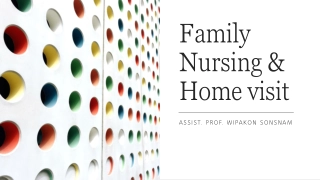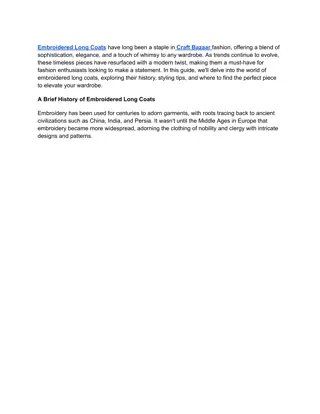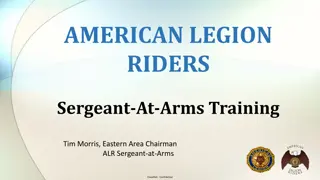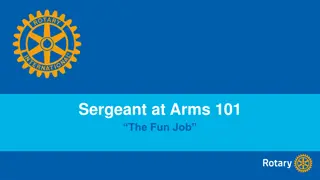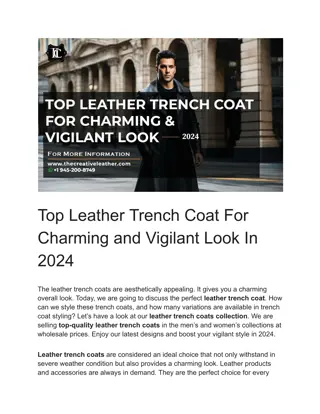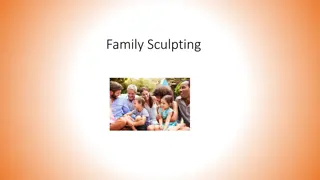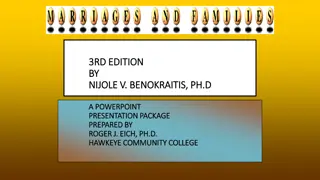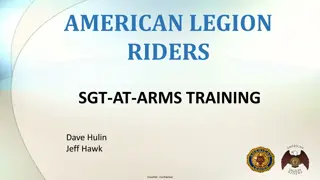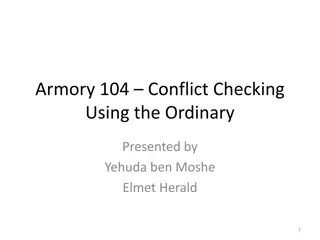Understanding Family Coat of Arms in Heraldry
Explore the origins and significance of family coat of arms in heraldry, including the evolution of designs from shields to tunics, the role of heralds in battles, key terms like blazonry and charges, and common symbols used in heraldic designs. Delve into the fascinating world of heraldry with rich visual examples and learn about the intricate elements that make up a coat of arms.
Download Presentation

Please find below an Image/Link to download the presentation.
The content on the website is provided AS IS for your information and personal use only. It may not be sold, licensed, or shared on other websites without obtaining consent from the author. Download presentation by click this link. If you encounter any issues during the download, it is possible that the publisher has removed the file from their server.
E N D
Presentation Transcript
FAMILY COAT OF ARMS Or Family Crest or Shield
THE BATTLEFIED Coat Armor At first knights used their coat of arms only on their shields. Then they started putting these designs on the tunics they wore over their armor. These tunics were also called coat armor- that is where the name coat of arms comes from. Soon flags, horse trappings, and tapestries all had coats of arms on them.
HERALDS During battles someone had to act as a messenger. Men called heralds performed this job. They wore special uniforms, called tabards, and did not carry weapons. Heralds would cross enemy lines for negotiations between armies. They were not supposed to share any information about the enemy s camp, or be taken prisoner. After a battle, heralds would make lists of those who had been killed in the battle. They could identify the dead knights from their coats of arms.
IMPORTANT COAT OF ARMS TERMS Blazonry is the heraldic language. To blazon a coat of arms is to describe the symbols and colors upon it in a brief and precise order. Heraldry is a very old visual language that was originally used to identify warriors. Men in armor looked alike, so each knight chose a symbol and color that distinguished him from all the others. This became the coat of arms .
IMPORTANT COAT OF ARMS TERMS Charges. The common charges you can place upon your field are plants, animals, celestial objects, inanimate objects, parts of the human body, and birds. Field- The whole surface of the shield. Furs- special patterns on the field. Ordinaries- simple shapes or a way to divide the space of the field.
COMMON CHARGES Animals- lion, deer, bear, fox Birds- eagle, dove, crane, peacock Inanimate objects- anchor, tower, horseshoe Plants- oak tree, shamrock, holly Celestial objects- crescent, etoile, sun Body parts- arm, head, hand Other charges: centaur, sphinx, griffin, hydra (type of dragon), mermaid, unicorn
PLAN YOUR FAMILY SHIELD. DRAW A SKETCH. USE THE EXAMPLES TO HELP YOU SELECT SYMBOLS THAT WILL REPRESENT YOU. *See requirements on your table top.
DRAW YOUR PIECES ON CARDBOARD AND CUT THEM OUT. Thicker cardboard is for the bottom. Thinner cardboard is for the top pieces. You should be able to use scissors for all cutting. Some shapes will need to be simplified. Stack and glue them together.
GLUE YOUR CARDBOARD PIECES DOWN. Use Elmer s Glue to hold the pieces down. Add some small pieces to add texture (fabric, noodles, beans, buttons, etc.)
METAL TAPE ART HTTPS://WWW.YOUTUBE.COM/WATCH?V=HLJO8 W-0IPK&INDEX=3&LIST=PLFLQ7M- NJNPAPAIGTJAAKDRAVABWXQRT_ Cover your shield with metallic tape.
Project Requirements: Meet project requirements: include family coat of arms, name or initials, charges, fur or ordinaries Creativity (of ideas or applications of materials) Composition (arrangement, texture, color) Craftsmanship (neatness & ability to use materials- cardboard, tape, paint) Effort Labeled (first and last name, date, and class period)


